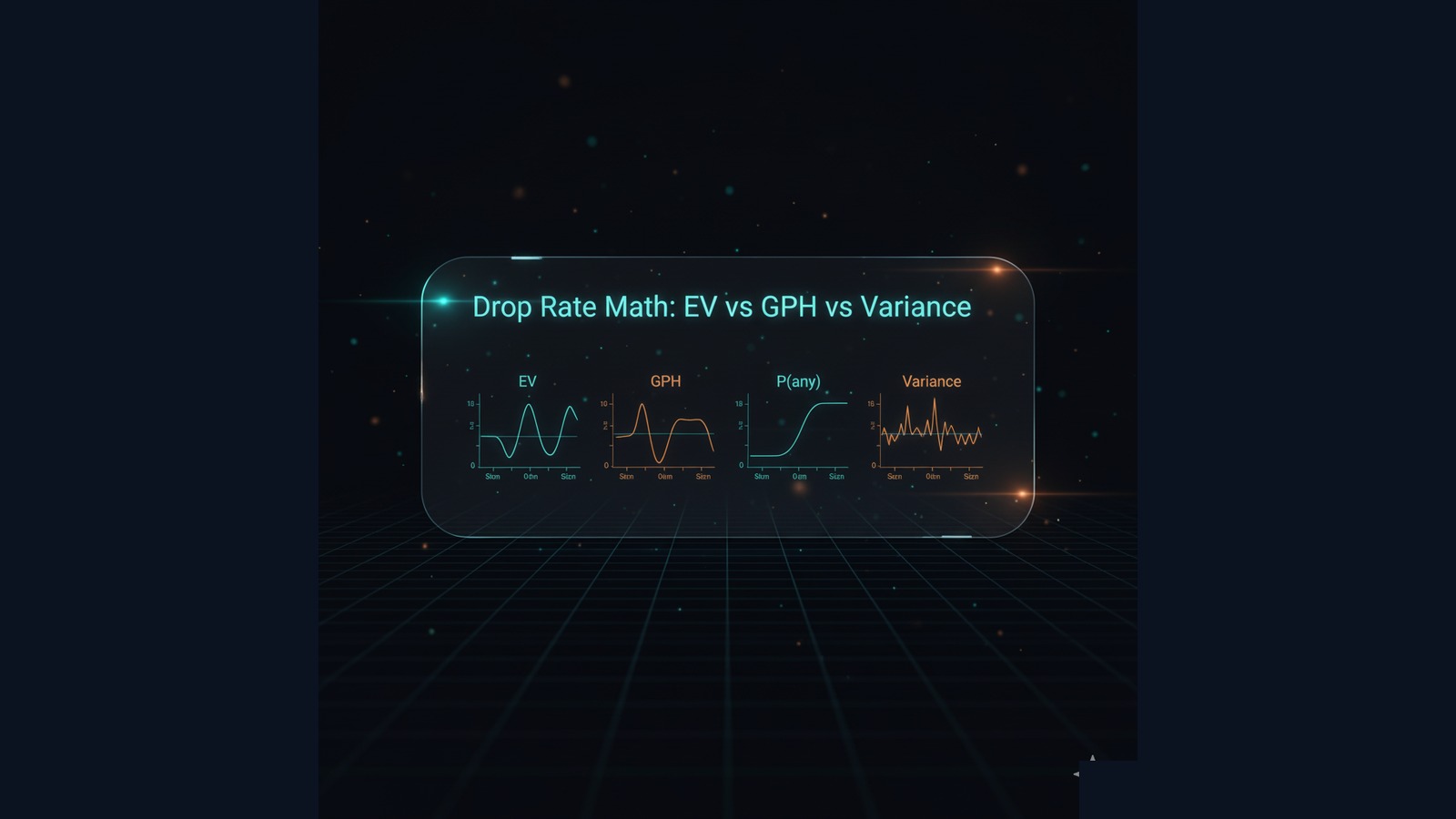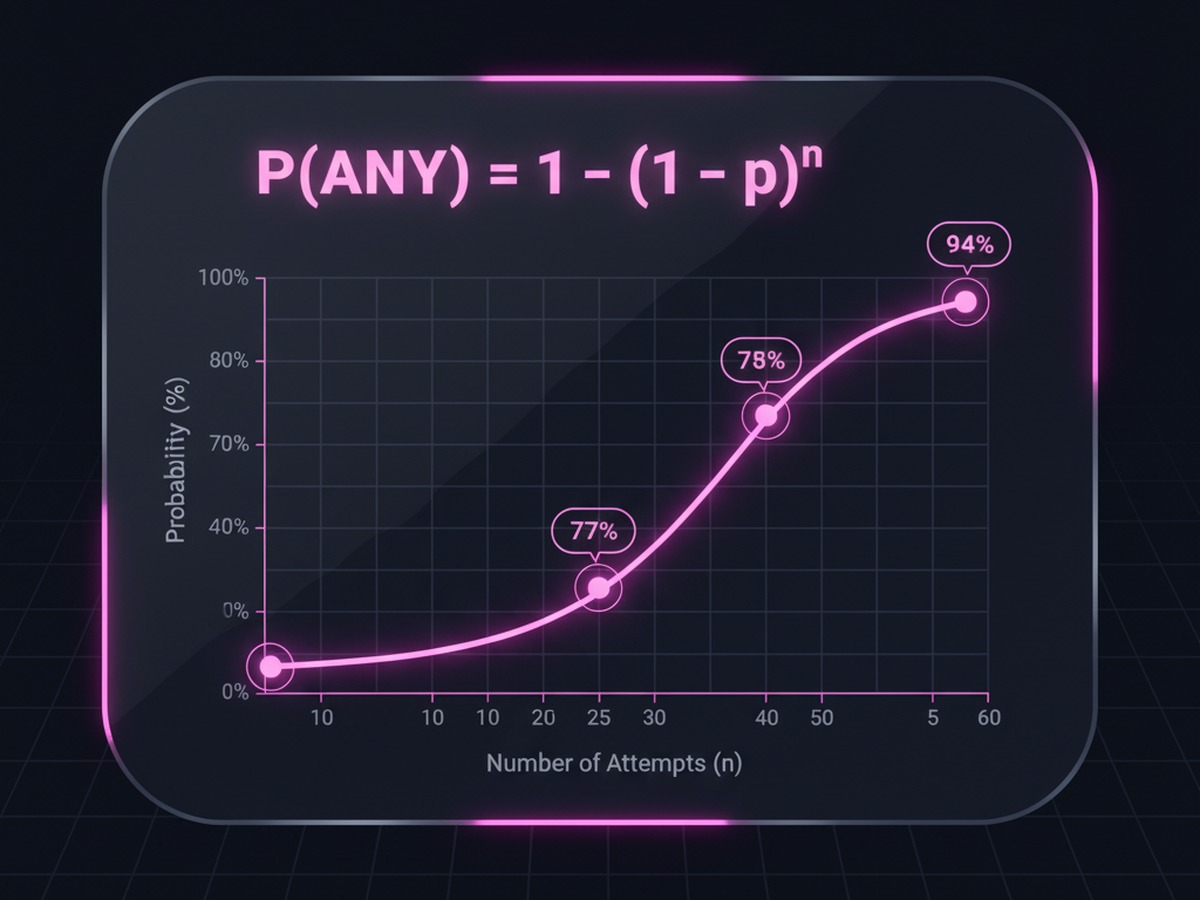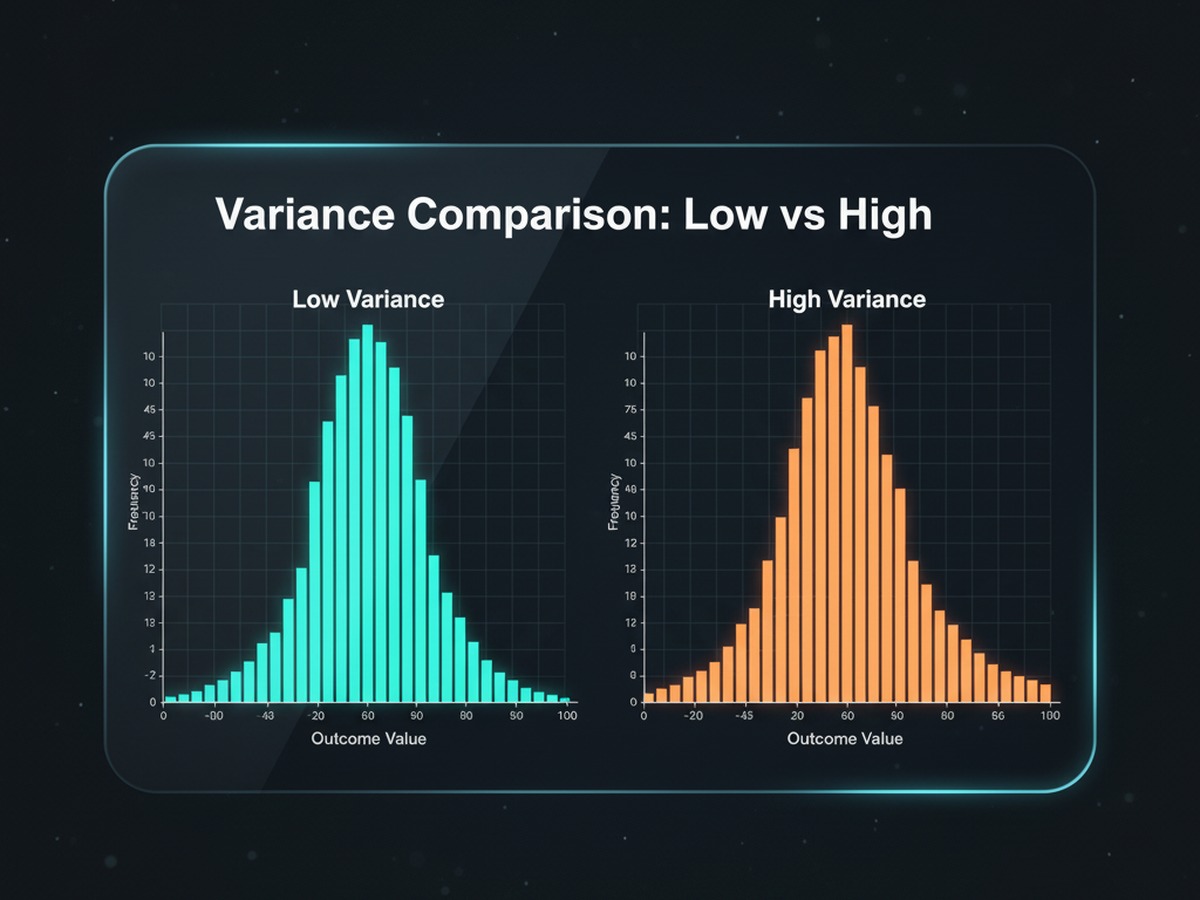Drop Rate Math in Games: EV vs GPH vs Variance (2025 Guide)

This guide unifies the math behind loot randomness: expected value (EV), gold per hour (GPH), variance, P(any), and pity systems. Every formula is reproducible, and each example deep-links to an interactive calculator so you can plug in your own numbers.
What Is Drop Rate Math? EV, GPH & Variance Explained
Expected Value (EV) – Average Loot Per Action
EV Formula (Weighted Average)
EV = Σ (value_i × probability_i)Key Takeaway
EV is neutral to time; it tells you how valuable a chest is, not how fast you open them.
See Also
Gold Per Hour (GPH) – Time-Normalized Efficiency
GPH Formula
GPH = EV × actions per hourPractical Note
When you optimize routes, GPH moves first; EV/chest moves later when you change targets.

See Also
Variance & Volatility – Why Streaks Happen
Variance Intuition
- Jackpot-at-low-probability ⇒ higher variance.
- Many small steady drops ⇒ lower variance, smoother income.
Decision Tip
If you dislike dry streaks, accept slightly lower EV for lower variance.
See Also
Formulas You'll Actually Use for Loot Drop Rates
P(any) Across Multiple Attempts (Union Probability)
At Least One Success
P(any) = 1 − (1 − p)^nExample: p = 5.8%, n = 25 ⇒ P(any) ≈ 77%.
Use Cases
"What are the odds I see any unique in 25 Barrows chests?"

See Also
Binomial Distribution – "K or More" Drop Counts
Probability of Getting At Least K Successes
P(≥k) = Σ from i=k..n [ C(n,i) · p^i · (1−p)^(n−i) ]Confidence Intervals
From observed samples, create a 95% CI for the true drop rate p. More runs ⇒ tighter CI; fewer runs ⇒ wider CI.
See Also
Game Examples: Diablo 4, OSRS Barrows, WoW Delves
→Diablo 4 Helltide – EV Per Chest vs Route Speed
EV/chest comes from Tortured Gift tables and your price model. Chests/hour depends on cinders/hour and travel time. Try your loop in the Helltide Loot Calculator.
Insight
Raise cinders/hour or shorten travel time → GPH can soar even if EV/chest is unchanged.
Action
Start with a 70% Mystery / 30% Regular mix, then tune to map density.
Related
→OSRS Barrows – P(any) and EV/Run
Per-chest unique odds p feed P(any) via 1−(1−p)^n. EV/run includes runes/uniques; run time converts EV/run into GPH. Use the Barrows Calculator and our unique-odds guide.
Insight
"Faster runs" can beat "higher EV per chest" once you normalize by time.
Tip
Bank presets + consistent routing reduce variance and improve hourly yield.
Related
→WoW Delves – Vault Thresholds vs GPH
Pick a tier you clear comfortably; then check weekly vault thresholds (S3 requires 40 chests). GPH = EV/chest × chests/hour. Use the Delves Calculator and the tiers & thresholds guide.
Insight
For threshold goals, the "fastest to 30/40 chests" often beats "highest EV per chest".
Tip
If wipes spike at T8, dropping to T7 may increase overall GPH.
Related
Variance, Dry Streaks & Confidence Intervals (Stop Tilting)
Why Variance Explodes with Jackpots
Route Design
Pair a low-variance activity (steady income) with a high-variance target (jackpot hunting).
Bankroll
Allocate session time; don't rely on the jackpot to pay this hour.
See Also
Estimating Real Drop Rates from Samples
Practical Rule
Fewer than 200 trials ⇒ wide CI; avoid overfitting a single day's luck.
Communication
Publish EV with CI and GPH with CI when sharing routes with your group.
See Also

Practical Farming Workflow & Route Optimization (Step-by-Step)
Step 1 — Baseline EV/Action (or EV/Run)
Tooling
Use LootCalc calculators and export/share URLs as baselines.
Output
EV with a short note on sources/assumptions.
Internal Links
Step 2 — Measure Time & Density
Compute GPH
GPH = EV × actions/hour. If GPH trails peers, change pathing first; only then revisit targets.
Example
D4 Helltide 45s/chest → 80 runs/h; trim to 40s → 90 runs/h = +12.5% GPH.
Internal Links
Step 3 — Quantify Variance & Set Expectations
Report P(any) & CI
Label high-variance routes "jackpot-heavy," so teammates expect streaks.
Maintenance
Re-benchmark each patch/season; prices and tables move.
Internal Links
Common Mistakes in Drop Rate Calculations (Avoid These)
❌ Mistake #1: Confusing EV with GPH
The Error: "This chest has 50k EV, so it's better than the 40k chest."
The Fix: Always normalize by time. If the 50k chest takes 90 seconds and the 40k chest takes 45 seconds, the 40k chest delivers higher GPH (53.3k/hour vs 33.3k/hour). Use a drop rate calculator to compare time-normalized returns.
Rule: GPH = EV × actions per hour. Optimize GPH, not raw EV.
❌ Mistake #2: Adding P(any) Probabilities Incorrectly
The Error: "5% drop rate × 25 attempts = 125% chance." This violates basic probability (you can't exceed 100%).
The Fix: Use the union probability formula: P(any) = 1 − (1 − p)^n. For p = 0.05 and n = 25: P(any) = 1 − 0.95^25 ≈ 72.3%, not 125%.
Tool: The Barrows Calculator automatically computes P(any) for multiple chests.
❌ Mistake #3: Ignoring Variance When Comparing Routes
The Error: "Both routes have 100k GPH, so they're identical."
The Fix: Route A might give steady 95k-105k per hour (low variance), while Route B swings 50k-150k (high variance). If you need consistent income for repairs/consumables, choose Route A even at slightly lower EV.
Psychology: High variance feels frustrating during dry streaks. Many players prefer 95k stable over 100k volatile.
❌ Mistake #4: Assuming Pity Systems Are Pure RNG
The Error: Applying binomial formulas to gacha games with soft/hard pity (e.g., Genshin Impact).
The Fix: Standard formulas assume independent rolls. Soft pity gradually increases odds (0.6% → 2.0%), and hard pity guarantees success by pull 90. You must simulate or use specialized calculators that model pity mechanics.
❌ Mistake #5: Over-Trusting Small Sample Sizes
The Error: "I got 3 drops in 20 runs, so the real rate is 15%!"
The Fix: With only 20 trials, your 95% confidence interval is extremely wide (roughly 3%–34% for 3/20 observed). Collect at least 200–500 samples before claiming accuracy.
Statistics: Use confidence intervals to quantify uncertainty and avoid overfit.
Frequently Asked Questions (Drop Rate Math FAQ)
Q: What's the difference between drop rate and drop chance?
A: In most contexts, they're synonyms (e.g., "5% drop rate" = "5% drop chance"). Technically, "drop rate" can refer to frequency over time (drops/hour), while "drop chance" is probability per action. Always clarify which you mean when sharing data.
Q: How do I calculate expected value (EV) for a loot table?
A: Use the weighted average formula:
EV = Σ (value_i × probability_i)Example: Chest drops 10k gold (90% chance) or 100k gold (10% chance). EV = 0.90×10k + 0.10×100k = 9k + 10k = 19k per chest. Multiply by chests/hour to get GPH.
Q: Why does my actual gold per hour differ from calculated GPH?
A: Three main reasons:
- Variance: Short-term luck swings around the mean. Run more sessions to converge.
- Hidden time sinks: Banking, inventory management, travel between spawns add 10-20% overhead.
- Outdated prices: Market values shift daily. Re-price weekly or use live API data.
Q: Should I farm high EV or high GPH activities?
A: Always prioritize GPH (gold per hour) for time-efficient farming. High EV per action is only valuable if you can complete many actions per hour. A 100k EV chest that takes 5 minutes (1.2M GPH) beats a 50k EV chest that takes 30 seconds (6M GPH).
Q: How many runs do I need to accurately measure a drop rate?
A: For a 95% confidence interval within ±2%:
- 5% drop rate: ~456 runs
- 1% drop rate: ~9,600 runs
- 0.1% drop rate: ~384,000 runs
Rare drops require massive sample sizes. Use community-aggregated data when available.
Q: Can I use these formulas for gacha games with pity systems?
A: No. Standard binomial and P(any) formulas assume independent rolls. Soft pity (increasing odds) and hard pity (guaranteed drop) break independence. You must simulate or use game-specific calculators. For Genshin/Honkai/HSR, check specialized gacha calculators that model pity mechanics.
Q: What tools can I use to calculate drop rates automatically?
A: LootCalc provides game-specific calculators:
- Diablo 4 Helltide Calculator – EV per chest, cinders/hour, GPH optimization
- OSRS Barrows Calculator – Unique probability, rune EV, run efficiency
- WoW Delves Calculator – Tier comparison, vault thresholds, time-to-goal
All calculators support URL sharing so you can export/compare setups with teammates.